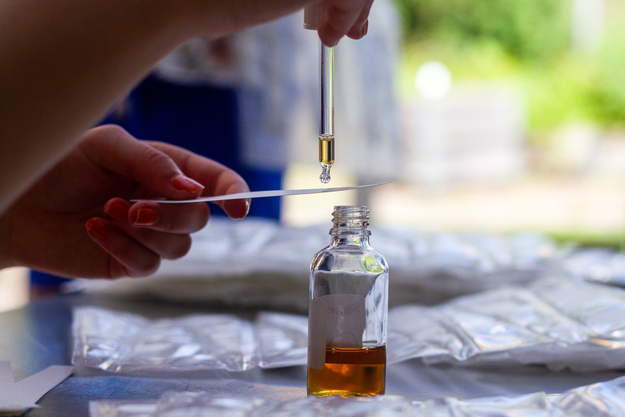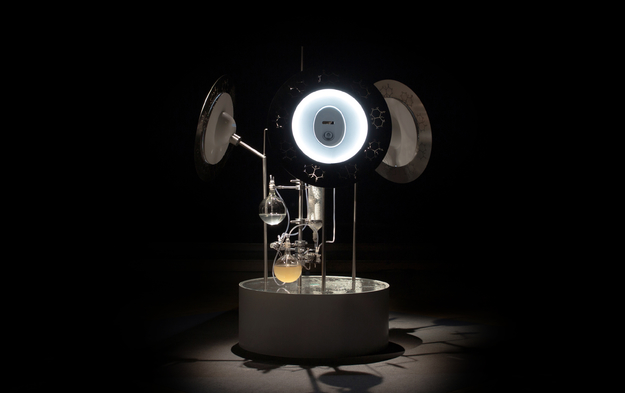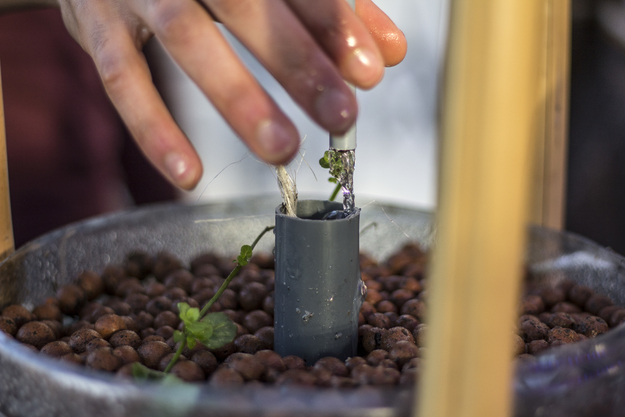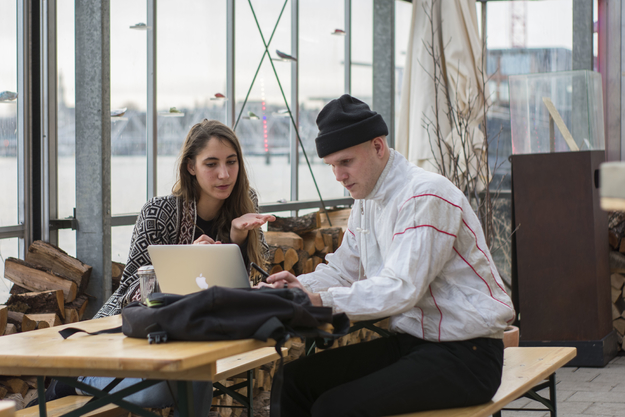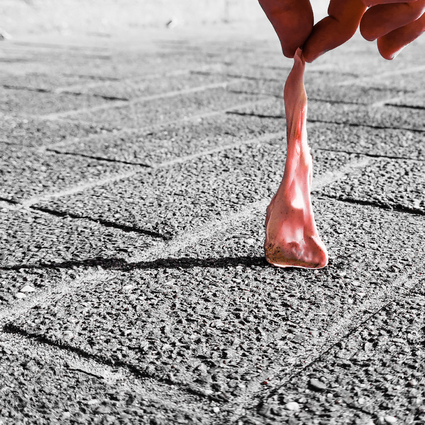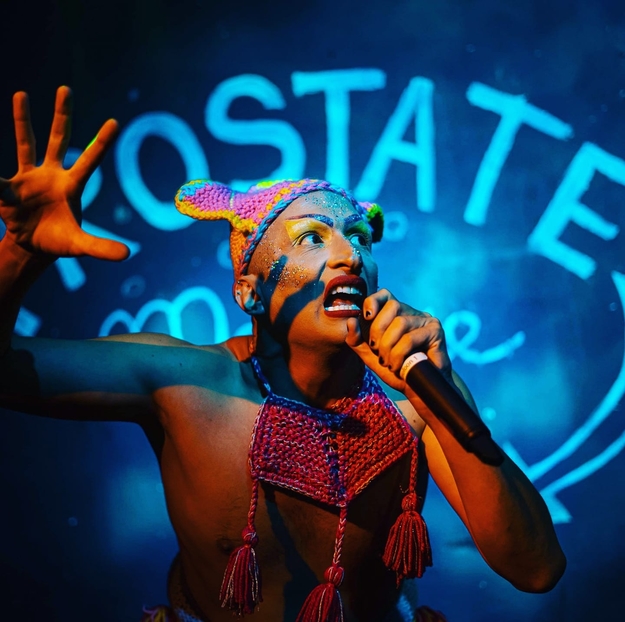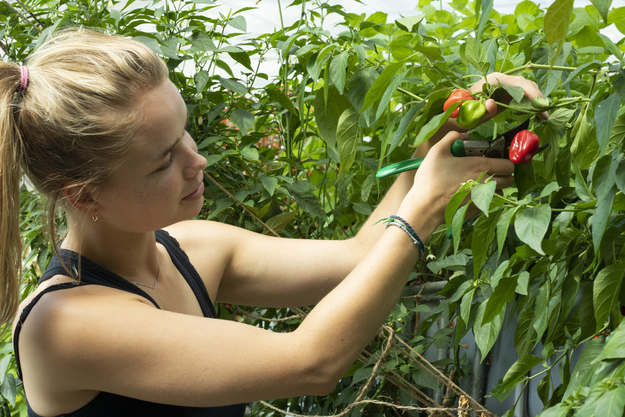Serres Séparées
Serres Separees - Experimenting with the redesign of togetherness.
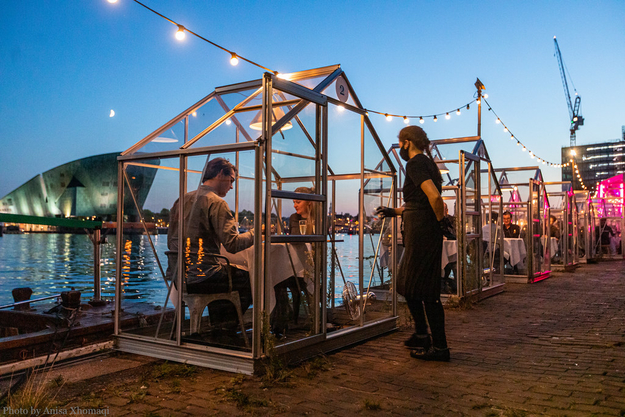
During Covid-19 virus times we are intrigued by contamination precautions and the redesign of togetherness. How can we rethink a restaurant and dining experience?
Dining in a personal small greenhouse! Our greenhouses protect you from the outside and others while offering you a unique experience of intimate dining.
The Serres Separees are copied worldwide, have been the Dutch contribution to the Dubai Design Week and got a lot of media attention. Want to make a corona proof dining place yourself? Check our website and we explain precisely how to do it.
In restaurants and bars, a separate room is traditionally named in French: "chambre séparée". It suggests a sexy kind of intimacy, here things can happen that should remain hidden from plain sight and not be heard by all. We've decided to name our greenhouses in French too. Although what happens inside will be a lot more public…
Still Life
Space for a final goodbye - Made by Abbey Hoes at Mediamatic Sluisdeurenloods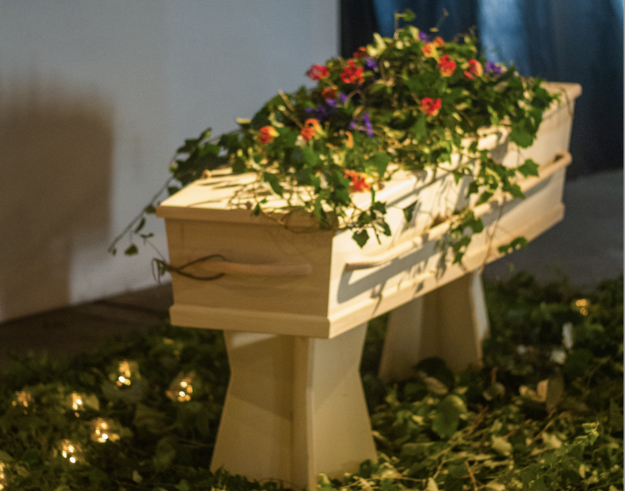
We explored new approaches and designs for our own inevitable death with progressive funeral director Susanne Duijvestein. Lectures and workshops about architecture, rituals, life stories and the variety of death.
Space for a final goodbye
How can we contribute to society during a lockdown? All forms of life are given a place at Mediamatic. Death was already one of our interests, so it seemed a natural choice to offer our biotoop as a place to say your final goodbyes. Together with Susanne Duivensteijn, our curator death, we designed ways to be an open, inclusive and creative venue for last rites.
As a funeral location, we work closely together with families and undertakers, to design a proper goodbye. To make this farewell as beautiful and safe as possible, we provide the creative spirit of Mediamatic.
Odorama
In 2020 we continued our lecture program about smell, art and design.
In spite of the measurements, we hosted all 7 lectures in 2020, but with a little more creative effort. We learned how to distribute smells, by designing a blottersystem that fits through the mailbox. This way, part of the guests could attend in real life, and the other part could follow the lectures at home, while still being able to smell, touch and taste.
Odoroma: Little Red Riding Hood and the Smell of fear
In januari, we smelled the flowers that caused Riding Hood to go off her trail and sense the Wolf's fur. How can smell be used to tell a story? Can smell enhance the experience of a fairytale? And did you know amusement parks and cinemas use smells to influence guests?
Speakers: Jan Jedenak, Jonas Klinkenberg, Jasper de Groot, Dik van der Meulen, Frank Bloem
Odorama: The smell of rain
Most of us remember how the streets smell after a summer rain. At the Odorma 'The Smell of Rain' we looked closer into the smell of what is called: petrichor. This smell petrichor is partly caused by the organic compound geosmine and bacteria that help organic matter decay. Over time these build up under stone and earth, the rain releases their perfume. The Smell of Rain is an homage to this natural phenomenon. We looked into the microbes that cause the pleasant smell after rain, humans' sensitivity to geosmine and the art installation by Saša Spačal that has captured this distinct scent.
Speakers: Saša Spačal, Leanne Wijnsma, Rosalie Bak, Henk Jonkers, Frank Bloem
Odorama: Parfum Funebres
Plagues and diseases have tortured us since time immemorial. Thanks to our ingenuity, we have protected ourselves behind a wall of vaccinations for several years. This created a false feeling of safeness. Looking back upon the history of pandemics, we can witness an interesting role of scents. For example, plague doctors believing in the miasma-theory thought that putting fragrances in the 'beaks' of their plague masks could protect them. We researched how the miasma theory fits in with the current pandemic, and discussed the role does scent play in death ceremonies.
But we were also interested in the role of smell in memorating deceased. We talked about how we can reconstruct the smells of our passed loved ones.
Speakers: Frank Bloem, Susanne Duijvestein, Caro Verbeek, Steffie Baaijens, Josely Carvalho
Odorama: The Bitter Essence
During this Odorama we took the audience on a bittersweet trip and challenge you to explore the word of bitterness in your mouth and your mind. Chocolatier Sabien Poutsma made our mouth water with her story on the darkest of chocolate. Education professional Kees Wabeke showed us a school children's gardening project at the Rijksmuseum. And former neuroscientist turned beer sommelier Bas Visser turned us on with his talk on Oedipus Brewing. Last but not least, artist Sarojini Lewis told us about the bitter taste of the migrated vegetable called karela as a metaphor for her migrated ancestors, leaving everyone with a bitter, but beautiful, taste.
Speakers: Caro Verbeek, Kees Wabeke, Sabien Poutsma, Bas Visser, Sarojini Lewis
Odorama: Odor Ludens
We dived into the smelly world of nostalgic toys and researched connections that our brain playfully makes in between toys and its smell. We explored how certain odours might have influenced our minds while playing in the past, and also discussed if it is possible to use fragrance in toys to positively manipulate our children in the future.
We were not limited to childhood toys, as we also had a look at animals and the objects that they play with, and talked about aroma's of sex-toys designed for adults.
Speakers: Frank Bloem Alissa Rees Caro Verbeek Thijs de Zeeuw Jonathan Ho
Odorama: Law & Odor
Smell is a powerful tool that can tell us when we should mistrust a situation, or when we should suspect something. Often you can literally smell if a case is not amiss, or when your neighbor is running an illegal business. Think of scent-traces that can be found on a crime scene. What does blood smell like? Is it complicated to erase the scent of evidence? and can you smell it when your neighbor is running an XTC lab?
Laws and restrictions of smell are also essential to make our cities liveable. We all prefer to live in a city that does not stink, but how far are we willing to go? Looking at the numerous cases of neighbors fighting about odor nuisance, it becomes clear that we often disagree on this topic. Do you think you are allowed to forbid your renters in their contract to cook with smelly spices? And can someone get a fine because he has a stinking pet?
During the odorama we discovered what you are not allowed to do with smells, we explored the boundaries of illegal scents, and asked ourselves if we actually have the right to stink.
Speakers: Laura Burgers, Inger Leemans, Frank Bloem, Gwen van der Zwan, Ton van Harreveld
Odorama: Can you smell blue?
Can you imagine that you could hear the colour blue, or taste a music piece? For some people this sensorial experience, called synesthesia, is part of their everyday life. In this diverse evening with lectures and performances, we dived into the world of synesthesia.
Speakers: Caro Verbeek, Amy Toner, Ibo Bakker , Han van der Vegt, Tessa van Leeuwen, Anton Dorso, Francesca Strik Lievers
Exhibition:
Meta_Bolus
Meta_bolus, by Sasa Spacal, exposes the planetary metabolic process as an exchange of certain boluses or doses that define relationships between agents as either beneficial or adverse. The Streptomyces bacteria in the installation emit a seducing geosmin aroma, a single sniff of which can evoke the memory of a forest after rain. The aroma of wet leaves is intertwined with the history of human resistance to antibiotics. In the Anthropocene, agents are immersed in the planetary metabolic flow in which pharmacological doses are asymmetrically exchanged. Humans are no exception and non-selective pharmacological negligence can result in deadly consequences. Can humans smell the rising resistance to antibiotics?
Open Tour
Mediamatic Biotoop at Sunset - No filter and still SUPER kitchy!
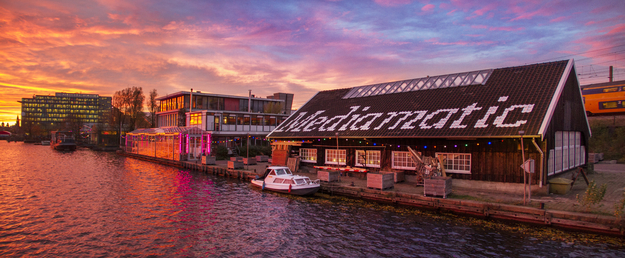
It's been a successful year of open tours. This year we also opened our doors for the curious visitor. During our tours we walked along all our different rooms and installations and gave the visitor an impression of the rich life in the Biotope. Come explore Mediamatic as part of our weekly Friday Tour at 16:00.
Workshops
NEW: Observational Plant Drawing
Seeing is knowing is seeing is knowing...
A biology, foraging and drawing workshop in one! Together with biologist and artist Annemarie Verschoor, we guided participants through the different dimensions of plants and their anatomy and learned to recognise, draw, and understand the many shapes and lines of plants.
Fermentation
This workshop is full of tasting and interesting facts. Kombucha and Kimchi have endless taste possibilities, that participants learned to experiment with during the workshop. The workshop tutor, Saskia Frederiks, is a specialist in fermentation. After tasting water kefir once, she was hooked, and has been fascinated by fermentation ever since. The transformation in scent, color, taste and texture never seem to lose their magic for her. She likes to inspire others with her fascination for and knowledge about fermentation.
NEW: Discovering otoliths
The otolith is located in the inner ear of the fish, but also of humans. During this workshop we discovered the otolith in a fish’s head. Otoliths play a role in the mechanical perception of sound, acceleration and gravity. Just like with trees, an otolith has annual growth rings, from which the age of the fish can be calculated. We learned participants to work with a scalpel, magnifying glass, and other preservation instruments. After cleaning the otolith, participants transformed it into a real artwork that you can bring home.
NEW: Grafting Cacti
Grafting is a horticultural technique in which you join multiple plants and make them grow as one. During this workshop, Martijn Baas will thought you the basics of grafting and inspire you to design your own cactus, that can take on surrealistic and esthetically pleasing forms.
Distilling Fragrance and composing parfume
During this workshop, participants are be introduced to scent extraction and the distillation process. Distillation is the process of extracting essential oils from plant based materials. Using your own or materials from the Mediamatic grounds, you will distill your own artistic essential oil. In this workshop, artist, and perfumer Frank Bloem will introduce you to the world of perfume making. You will learn the basics of scent composing and at the end of the workshop, you will have theoretical knowledge on the principles of perfuming, on how to mix fragrant notes and on the difference between natural and synthetic smells. You will go home with a 10 ml bottle of your signature fragrance.
Sculpting textiles
In just 4 hours, Soldati will teach you the many techniques she mastered over the past years. During this workshop, you will learn how to manipulate textiles into 3D shapes. You will leave with a solid base to start your own practice of manipulating textiles and the knowledge on how to design patterns. During the workshop, you will put Soldati's techniques to practice. This includes practicing non-conventional techniques such as using clay or bio-plastic to substitute stitching, as well as using heat to transform textile into unlimited 3D shapes. This workshop is especially interesting for those wanting to work with textile and those interested in architectural shapes and sculptures. To continue your practice after the workshop, you will receive a booklet with 16 different techniques.
Growing mushrooms
The workshop will start with an informative session where Wouter introduces different growth media, substrates, cultivation methods and fungal strains, as well as the potential of mycelium. There will be enough time to ask any questions you might have about mushrooms. You will take home a bag of substrate to cultivate oyster mushrooms and with knowledge on how to extract spawn from fully grown mushroom.
NEW: Molding Mycelium: Plant Pots
It's obvious that we should re-think our destructive consumption behaviours, and mycelium can play a part in that. The living organism can be shaped into various shapes to create products that are 100% degradable. Come to get introduced into the possibilities of mycelium, learn how to mold and shape the bio-material, and create an earth-to-earth pot for your plants.
NEW: Doomer/Bloomer
How are you feeling about climate change? Are you a doomer or a bloomer? Whatever you feel, you are probably not alone. Countless memes are made and posted onto the internet that express emotions felt toward the incoming climate crisis. It is said that 90% of internet users view content, 9% edit or modify content and only 1% create that content. in Doomer/Bloomer, we gained an insight into this 1%, and developed our own creation to talk about climate change in this workshop. Does the 1% reflect your own feelings or do you have something more to say?
NEW: Kintsugi
Humans are not able to control everything. In this workshop, the participants experienced the philosophy of kintsugi, which embraces the flawed or imperfect. They practiced to accept the way things are and letting go of control. How? By ritually breaking dishes and glueing them together again in novel and golden ways.
NEW: Self design furniture
As a tribute to the work of communist furniture designer Enzo Mari, we organized a DIY furniture workshop. Crafting with tools and scrap-wood from our workshop.
Botanikurs 101
"I keep killing my plants" Is this you? Join this workshop and become the plant parent you always knew you could be. The workshops all had different themes such as cuttings, repotting, kokedema, epiphytes and living with houseplants. Plantmom Monai teached everyone how to be a good parent to your hosueplants.
Build your own Aquaponics system
Aquaponics is a sustainable food production system that combines the cultivation of vegetables and fish. It is one of the best ways to produce food in the city, because it hardly takes up any space. The fish excrement feeds the plants, and the plants clean the water for the fish. In this way, not a drop is wasted. In this workshop we learned how to build a miniponics system, a miniature, home-edition of the bigger Aquaponics towers.
Exhibition:
Precious Burden
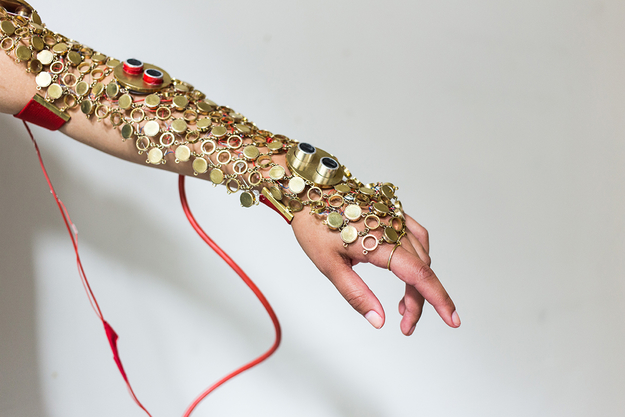
Autistic designer Asefeh Tayebani wants to use her work to increase understanding about her neurological condition. Her work allows the wearer to physically experience how on the spectrum being can feel. An electric shock over the arm or an unbearably sharp sound in your ear when the train passes is the daily reality of a large group of people around us. Tayebani is convinced that understanding the environment, themselves and perhaps other people with a condition can make them feel that they matter and that their condition should not be hidden away. Tayebani's work is exhibited in our Plant Room and can be felt every Friday during the Open Tour.
Meet-ups
In order to stimulate the cross-polination of ideas between public and artist, we host one on one meetings with the artists that show or make work at Mediamatic. These meetings are free of charge, and open to everyone.
Secretopia
Secretopia is an inquiry into human secretions through art, science, and design. In our events and blogs, we consider bodily fluids in association with artists and organizations to explore them in a multidisciplinary manner.
Chewing Gum
Djara van Hove was really annoyed by chewing gum that was laying on the concrete. She wanted to discover the deeper meaning of Chewing Gum. It has something mysterious about it. Although we all know it, we can say very little about it. Why don't we question it more? How did it begin? What are we chewing? Why do we chew it anyway? Chewing gum could be more than just a piece of chewy resin. What happens if we use the gum as a pure material and consider our 'frustration' as a source of inspiration.
Exhibition:
Light Observatory
Side view on Light Observatory during the opening - Picture by Zelda Bonnet 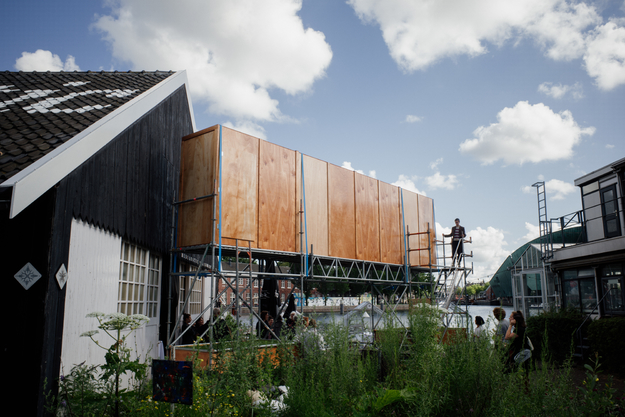
The installation plays at macro and micro levels (Astral movements and light photons entering the eye), and aims to create awareness on the relationship between both. The mind creates an image, and therefore we experience. But in truth, they are just an interpretation, defined by several axes that meet within the subject in a specific time and space and object. We are physically able to see much more than what we mentally allow ourselves to see.
“The [...] installation offers an incredible journey. With every taken step the visitor travels further away from the surrounding world until everything is gone. Looking back, in the end, just a single dot of reality is what remains. It is as if we are watching our sun from far away in space”. - Taconis Stolk and Edwin Van Der Heide
Exhibition:
Six-Winged Chicken
Pagina uit De Zesvleugelige Kip en andere fabeldieren van de voedingsindustrie - 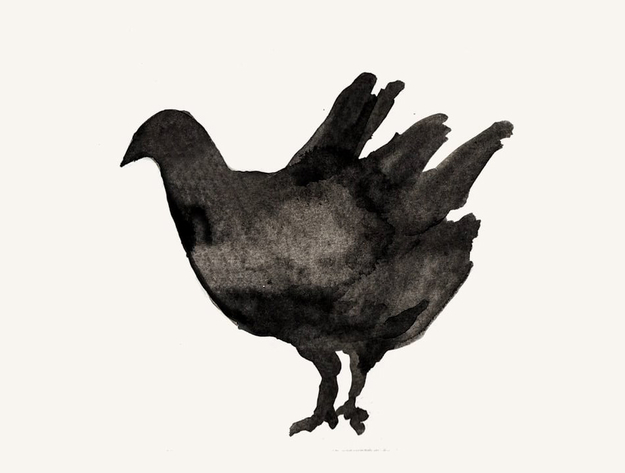
A few years ago stories circulated on the internet about Six-winged chickens. For a while, they seemed to exist. Various media wrote about them, with images of chickens with six wings. Whether this mythical creature really exists remains unclear.
In media nowadays it's hard to differentiate between real and fake news. Manipulating information is simple, and the sheer amount of news - whether fake or true - is overwhelming. This results in doubt, and the possibility of getting carried away by fantasy. Especially when facts are withheld or invisible, as is the case in the meat industry. Indeed, most people have no idea where the meat they eat comes from; it's hard to know when production takes place on such a huge scale.
In the book "The six-winged Chicken and other mythical creatures of the food industry" Anne Kamps explores the boundary between fact and fiction. She captures the zeitgeist, with its fake news, mad technologies, and a food industry further removed from humans than ever before.
Exhibition:
Tumulus II
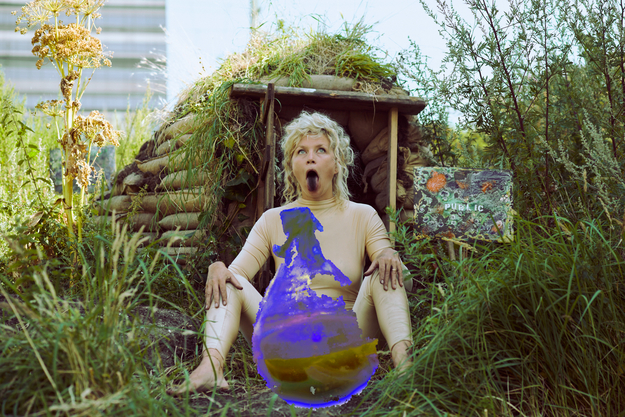
Tumulus is an enclosed garden installation that functions as a natural ruin, compost heap, cement & soil sculpture, seedbed, earthwork, dyeing source, and dunghill. Over the course of 16 months from June 2019 to September 2020, artist Ruchama Noorda will transform the patch of greenery next to our Sluisdeurenloods into a living sculpture and performance site.
Exhibition:
Building Pigeon Towers
Arne Hendriks revealing the sixth tower at the Biotoop -

The mycelium pigeon tower is a constant process of one state moving into the next. After the mushroom harvest, the old mycelium bricks are used to build a tower, a tower aspiring to become soil, the soil bringing forth the corn, the corn eaten by resident pigeons that fertilize the soil with their droppings while corn foliage is turned into blocks of mycelium substrate to once again grow mushrooms.
In the autumn of 2020, we started experimenting with different shapes and methods to build this living cycle, and investigate material decomposition as part of the design process. Different towers will emerge at the Mediamatic Biotoop.
Haeckel Game
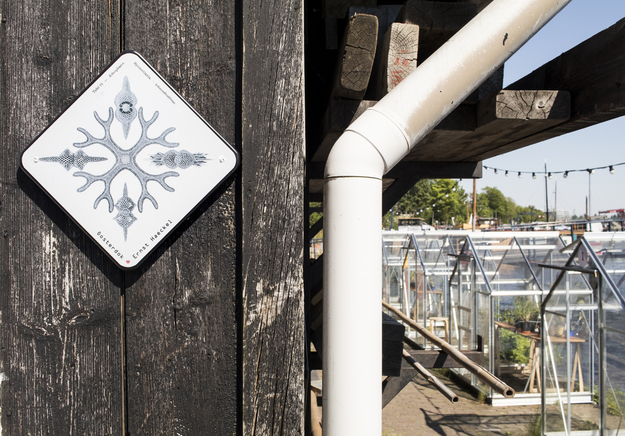
In 2020, we developed an app-game about the Kunstformen Der Natur from Ernst Haeckel. Throughout the Oosterdok, drawings of the Kunstformen Der Natur are spread for a partly digital and partly analog scavenger hunt. Everyone is invited to do the scavenger hunt for free, learn about Ernst Haeckel, and take a beautiful walk at the Oosterdok.
Open Aromalab
Frank Bloem voor een deel van het geurorgel -
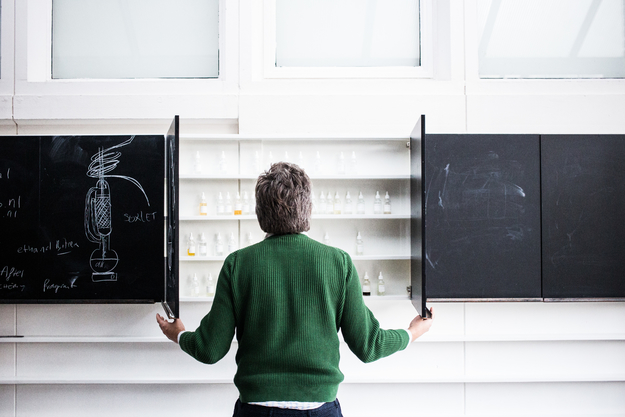
Every Thursday between 16:00 and 20:00, we hosted a blending session to create a bottle of perfume. Scent artists Frank Bloem and Nikklaus Mettler guided all interested people in the making of your own scent and made sure that everyone left the session with a basic idea of scent composition. We designed the Open Lab so that we were able to open our doors as much as possible, in spite of Corona.
Pride
There was no parade this year, but we wanted to celebrate identity in all its facets. That is why Mediamatic made a program during the pride week that gives an ode to the playground of identity, sexuality and intimacy: Queer Currents and MediaMasquerade.
On 18, 20 and 22 July we hosted a program by Queer Currents. Click here for the program.
On 25 and 26 July and 1 and 2 August we organised garment workshops under the title MediaMasquerade.
Neo-Futurist Dinners
Neo-Futurist Dinner August:
Skin Hunger
Skin Hunger 3 - Serving and massaging Picture made on 07-23-2020 at the Skin Hunger Photoshoot.
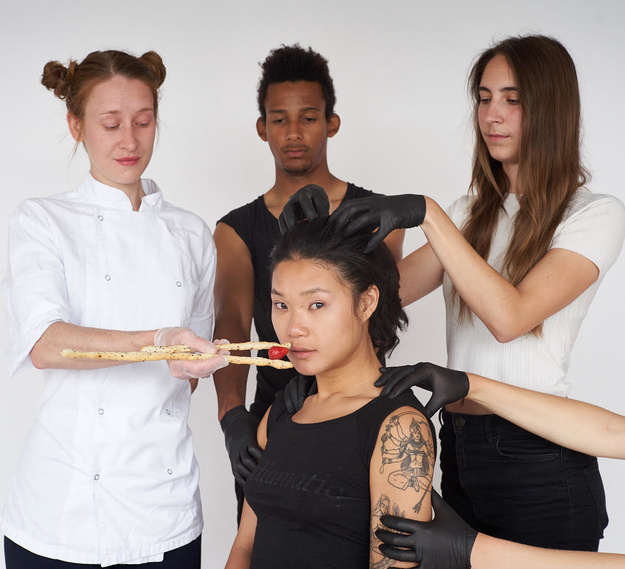
Our need to connect is as fundamental as our need to eat. A warm handshake, a sympathetic hug or a congratulatory pat on the back – even the most simple gestures can mean a lot to us. Being touched makes humans feel calmer, happier, and more sane.
Skin Hunger fulfilled the lack of physical contact in our modern times by performing an individual tactile breakfast experience. Artist chef Alice Héron and artist-in-residence Margherita Soldati explored the relationship between tactility and food through a 5 course breakfast experience. Skin Hunger combined massage and breathing exercises with food and bite-size sensorial dishes.
Neo-Futurist Dinner October:
Code Noir
Rachel Rumai Diaz taking a seat at the table - The premiére of Neo Futurist Dinner 13: Code Noir
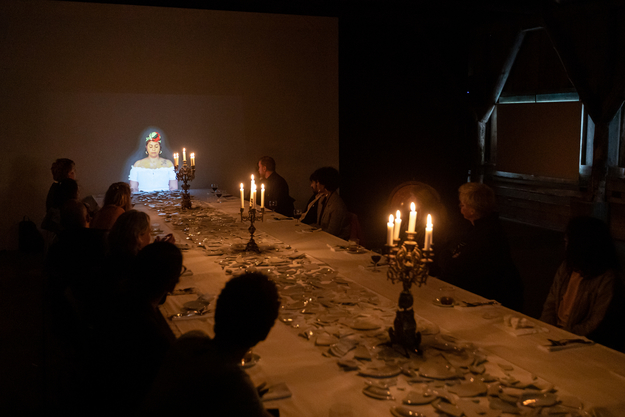
This 5-course Dinner experience was a collaboration between chef and culinary activist Lelani Lewis, spoken word artist Rachel Rumai Diaz, and artist Suzanne Bernhardt.
Code Noir took us on a culinary journey to get a better understanding of the cultural and colonial legacy of global trade routes, and its effects on Caribbean cuisine and culture. Code Noir was the name of a 17th Century decree restricting the freedom of the enslaved people in the French Colonies of the New World. At Mediamatic, Code Noir was turned into an immersive food experience that showed its guests how the worldwide exchange of goods has influenced current-day dishes – for the better or worse.
Japanese Knotweed
Many believe that the Japanese knotweed is a species that can only cause harm. This, however, is a very one-sided view on this exotic invader. In cities and gardens it might be a pain to get rid of, but is it also harmful in the kitchen? Japanese knotweed turns out to be of great nutritional value. It is an excellent source of Vitamin A and Vitamin C. We researched the value of Japanese Knotweed in nature and in the kitchen, and took a critical look at what an 'invasive species' actually means.
Olfactory History Oosterdok (OHO)
OHO, smell diving bell - Part of installation Mariko Hori, picture made by Mariko Hori.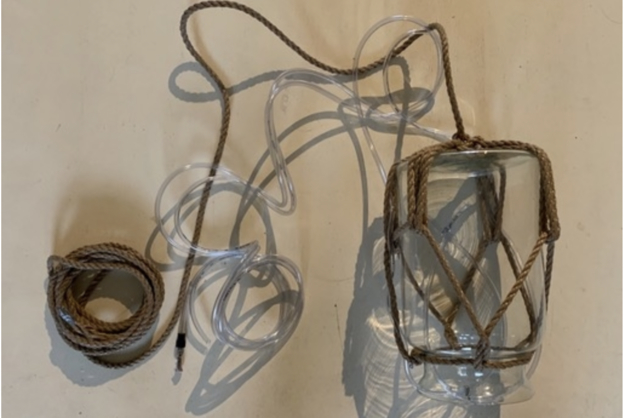
Merging scents and storytelling, we are researching the olfactory history of the Oosterdok. Our research and programmes initiated since 2019 lead towards revisiting the histories that have flowed through Oosterdok, or Eastern Dock, through more embodied and sensorial artistic practices. The Oosterdok area plays a crucial role in Amsterdam's growth since the Dutch colonial period to present times. We are curious about what hidden narratives a history of the "intimate senses" might reveal and about the role of smells, tastes and touch in the development of a city.
Gardening sessions
Corona poses a big threat to our health. But so does sitting at home all day. That's why we invited everyone who wants to join to help us with some mindfull gardening at the biotope, at our weekly gardening session. of course with every necessary precaution.
